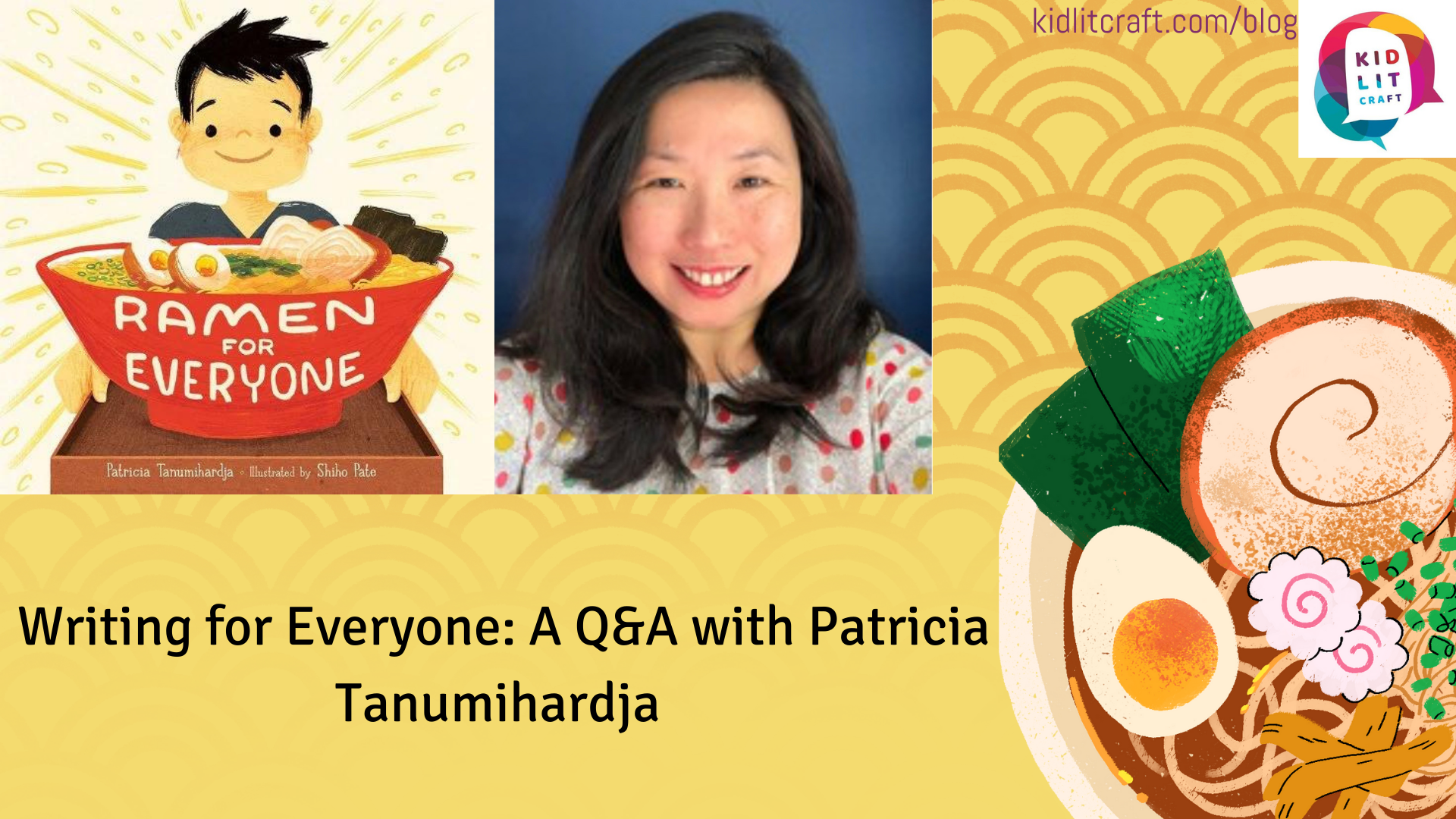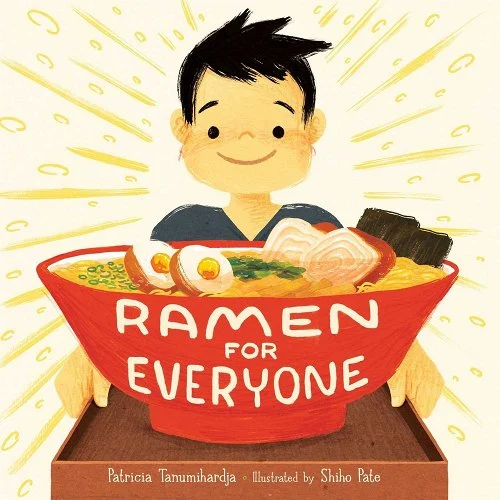interview by Anne-Marie Strohman
I first met Pat in a picture book writing class we took with Dashka Slater in 2015. Since then, we’ve been in a picture book critique group that still meets quarterly, all these years later. I’ve watched Pat grow in her picture book writing prowess over the years, but her enthusiasm about human connections, especially within families, and food have always been a part of her work. After reading multiple drafts of Ramen for Everyone, I was delighted to see the final product and how Shiho Pate’s fun illustrations bring Pat’s story to life on the page! As with any picture book, there’s a lot more to the story than what ends up on the page. Read on to find out the story behind the story! —Anne-Marie
KidLit Craft: Tell us about how you came up with the idea of Ramen for Everyone?
Patricia Tanumihardja: I started writing this story nine years ago when my son was about four years old. He absolutely loved noodles (and still does) and we took him to a ramen restaurant for the very first time. You should have seen how quickly he slurped up those noodles!
At the same time, I was watching the relationship between my son and husband develop. He really looked up to his dad and wanted to do everything that his dad did. So I really wanted to write a story about a father and son.
Workwise, I was developing a ramen recipe for my cookbook and reading about the ramen restaurants that were opening up in the U.S. Chefs were creating non-traditional ramen dishes and coming up with different toppings. I ended up merging these three things that were happening in my life and conjured Ramen for Everyone.
KLC: Was this a “one and done” book or did you go through many revisions?
PT: I looked through my folders and I counted about 80 different versions of this story!
KLC: As you were revising, what was the central inspiration you held on to? Did it ever go away in a revision? How did you get it back? How did you think about the theme of food and family as you were drafting and revising? How did you take the book to the next level–what gave it the extra special sauce?
PT: I read somewhere that world-renowned Japanese chef Nobu Matsuhisa’s philosophy is that food is imbued with the heart, or kokoro, and personality of the cook. And every bowl of ramen is a personal gift from chef to customer. Right from the beginning, I knew I wanted Hiro to learn to make food from the heart, and that I wanted him to realize that practice makes perfect and that he shouldn’t give up so easily. The bit about perfection came later but it was a natural segue.
In my first few drafts, Hiro was making ramen for his friends. In later revisions, I focused on just his family members because I realized that I wanted to weave together themes of food and family, in particular the father-and-son relationship. Food has always been a very important part of my family, both when I was growing up and now that I have my own family. My mom liked to cook and it was her way of showing her love for us. Similarly, I like to cook my husband’s or son’s favorite dishes and/or add in favorite ingredients here and there, just because I want to show them I “see” them and I love them.
KLC: In the middle of the book, there are a series of spreads where Hiro’s failure to make the different elements of a bowl of ramen–from broth to noodles to toppings–are completely in the art. Were those moments originally in art notes? Text? How did you and the editor, art director, and artist work together on those spreads?
PT: I had written a lot of sound effects for that part of the book, and I wanted most of Hiro’s actions to be described through the art. So yes, it was intentional. I did write lots of art notes and Shiho, the illustrator, did an awesome job bringing the scenes to life without us discussing anything.
KLC: I love the dad’s verdict that “This bowl is PERFECT for me!” rather than perfect, and the line “Hiro can’t make broth that is rich and flavorful YET!” Was that ending always what you were aiming for? If not, how did you find your way to the ending?
PT: My earlier drafts centered on Hiro finding his creative side. However, I slowly moved toward the idea that a “gift,” in this case, Hiro’s cooking, doesn’t have to be perfect but it could be perfect for the recipient. At the same time, I wanted to show kids that learning a skill, whether cooking or playing basketball, takes time and can’t be rushed. So even if you can’t do something well yet, it doesn’t mean you can’t improve and get there.
KLC: Your book ends with a note about ramen, some kitchen rules, and a recipe for Easy Miso Ramen. How did you decide what back matter to include?
PT: That was an easy decision. I wanted readers to understand the difference between instant ramen and the ramen I was writing about, and why I wrote the story I did. I’m all about teaching kids how to cook from a young age, so the recipe and kitchen rules were a must. Besides, I assumed that everybody was going to be hungry after reading my book so how could I not include a recipe?!
KLC: Community and connections can be such an important part of a developing writing career in children’s books. How have they been a part of your publication story?
PT: Both have played a huge part in my career. I wouldn’t be here if not for my critique partners, the like-minded friends I made through writing workshops and SCBWI, and the authors/instructors who have generously shared their insight with me. They have all been a source of strength and a network of support for me. I’ve also loved the process of “growing” together with my peers. One tip: it’s never too early to start cultivating these relationships, so even if you’re just starting your journey, seek them out!
KLC: What can fans of your book look forward to next?
PT: I have two more picture books coming out this year. Jimmy’s Shoes–The Story of Jimmy Choo, Shoemaker to a Princess and The Sugar Plum Bakers– A Tale of 12 Holiday Treats.
I’m also working on a few chapter books and a middle grade novel. And fingers crossed for another picture book about Hiro and his family!

Patricia Tanumihardja was born in Jakarta to Indonesian Chinese parents, raised in Singapore, and moved to Seattle for college. Besides her children’s books, she also writes cookbooks and stories on food, travel, and lifestyle.
In addition to Ramen for Everyone, she has two picture books coming out this year: The Sugar Plum Bakers: And the 12 Holiday Treats, illustrated by Bonnie Lui (Melissa de la Cruz Studio, 2023), and Jimmy’s Shoes: The Story of Jimmy Choo, Shoemaker to a Princess, illustrated by Derek Desierto (Abrams Books for Young Readers, 2023). She currently lives in Northern Virginia with her husband and son.
Find Patricia on Social Media:
It’s AAPI Heritage month! Learn more from some of our AAPI authors with these Q&As.
Anne-Marie Strohman (co-editor) writes picture books, middle grade novels, and young adult short stories and novels. She is trained as a teacher, an editor, and a scholar, specializing in Renaissance Literature. She holds an MFA in Writing for Children and Young Adults from Vermont College of Fine Arts and is an active member of SCBWI. Find her at amstrohman.com and on Twitter @amstrwriter.


COMMENTs:
0